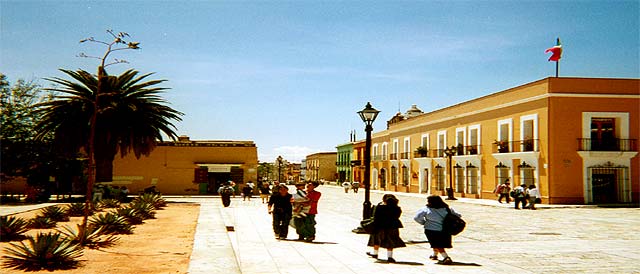
|
|
"Mexico
is the only country to the world, instinctively surrealist."
André
Breton
|
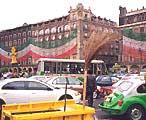
Zócalo,
México D.F. |
|
 Way of life
Way of life |
People
Mexico counts 100 million inhabitants among
whom 22 millions in the capital.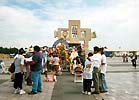 There is also a community of 20 million Mexican citizens
living in the United States. Most of people are half-bloods
with some groups of only European origin.
There is also a community of 20 million Mexican citizens
living in the United States. Most of people are half-bloods
with some groups of only European origin.
For the "rest", we consider directly 10 %
of natives going down directly Amerindian civilizations.
Very tolerant Mexico on this continent of violence,
is refuge for the "brothers" of Latin America,
fleeing the dictatorships.
The
language and the traditions
The official language is the
Castillan with a pronunciation 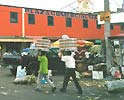 more
rounded off and more fanciful than in Spain.
About 50 Indian languages are spoken as Nahuatl, Maya,
Zapothèque. Although a little bit nationalist,
Mexicans remain opened and polished with the foreigners
(or gringos), which make the effort to speak about Spanish. more
rounded off and more fanciful than in Spain.
About 50 Indian languages are spoken as Nahuatl, Maya,
Zapothèque. Although a little bit nationalist,
Mexicans remain opened and polished with the foreigners
(or gringos), which make the effort to speak about Spanish.
Some some seem moved by the desire of those who have
ordained the uselessness absolved in any haste...
Family
and religion
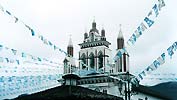 The
life in society is based on the importance of the family,
around a powerful and respected mother. The links to
the close friends and the godfathers and the godmothers,
are very strong. The main religion is the Catholicism.
Indians practise the syncretism, mixing Christianity
and original ancestral faiths. The
life in society is based on the importance of the family,
around a powerful and respected mother. The links to
the close friends and the godfathers and the godmothers,
are very strong. The main religion is the Catholicism.
Indians practise the syncretism, mixing Christianity
and original ancestral faiths.
|
 The
exchanges
The
exchanges |
The
market economy
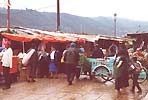 In
a system at the same moment organized and chaotic, coexist
modern and ancestral economies. The North of the country
is rather rich and industrialized whereas the South
is poor and rural. By the various markets and the itinerant
salesmen, the street remains a place of meeting, exchange
and communication. Although alimentary, the multitude
of small jobs allows to maintain a social link. In
a system at the same moment organized and chaotic, coexist
modern and ancestral economies. The North of the country
is rather rich and industrialized whereas the South
is poor and rural. By the various markets and the itinerant
salesmen, the street remains a place of meeting, exchange
and communication. Although alimentary, the multitude
of small jobs allows to maintain a social link.
Means of transportation
With
its immense armada of bus, bus, taxis and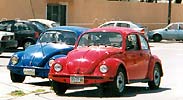 cycle, Mexico is the country of the public transport.
Those who have the means to buy to himself a car (and
the driving licence), drive generally in cars of German
or American brands. The speed limit is imposed by the
presence of "Tope" (effective speed bumps
in cement).
cycle, Mexico is the country of the public transport.
Those who have the means to buy to himself a car (and
the driving licence), drive generally in cars of German
or American brands. The speed limit is imposed by the
presence of "Tope" (effective speed bumps
in cement).
Information
and communication
The Mexicans are kings of the visual piece of information
on walls or on vehicles,  by
using essentially of the painting. The post being little
developed, the public communicates rather thanks to
telephones with cards and the electronic mail in cybercafes.
But if it is possible, most of the reports speak orally. by
using essentially of the painting. The post being little
developed, the public communicates rather thanks to
telephones with cards and the electronic mail in cybercafes.
But if it is possible, most of the reports speak orally.
Besides, the alive atmosphere of the street, it is very
considerable to notice that very few persons smoke some
tobacco in the public places. On the packages of cigarettes,
is even registered the mention " the tobacco provokes
the cancer ".
|
 The
underside of the decor
The
underside of the decor |
Disparities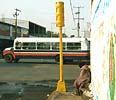
The
financial crisis of 1994 and the economic globalization,
continues to dig distances. More than 53 of the 100
million Mexicans live with less than 34 pesos ( 3.5
US dollars) a day, to meet their needs. Among them,
half live in a state of "extreme" poverty
notably in campaigns.
The
Indian question
While
the Mexican tourism  advances
the Amerindian roots, his direct descendants are always
handled at the bottom of the scale, in spite of the
enactment of a native law. advances
the Amerindian roots, his direct descendants are always
handled at the bottom of the scale, in spite of the
enactment of a native law.
Indians are even sometimes victims of murders, committed
by paramilitary groups or landowners (Chiapas, Guerrero,
Oaxaca).
An
underlying violence
The disparities favor a climate
of insecurity 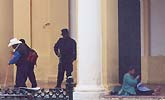 (kidnappings
of rich persons, thefts, murders). The traffics in any
kind (imitations, corruption, drugs) are also at the
origin of the violence, in spite of the massive presence
of polices, in the multiple uniforms. (kidnappings
of rich persons, thefts, murders). The traffics in any
kind (imitations, corruption, drugs) are also at the
origin of the violence, in spite of the massive presence
of polices, in the multiple uniforms.
Concerning " the export " towards the United
States of Mexican marijuana and Colombian cocaine, certain
politicians and militaries would be suspected to be
directly implied (Tijuana, Juarez, Yucatán).
Ecology
 The
strong concentration of the population and the lack of
environmental politics, engenders problems of pollution,
treatment of water and management of the waste. The
strong concentration of the population and the lack of
environmental politics, engenders problems of pollution,
treatment of water and management of the waste.
The forest, the real lung of the country, is threatened
by the extensive agriculture.
Authorities try nevertheless, to put little by little,
more means of action and protection (sensitization of
the public, creation of nature reserves).
|
|
|

